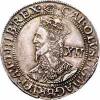Search the Community
Showing results for tags 'bristol testoon henry 8 ws m'.
-
info@petitioncrown.com www.petitioncrown.com https://www.facebook.com/petitioncrowncoin Henry VIII (1509-1547) Silver Testoon – A rarity struck just before Henry 8 death, it could also have continued to be struck after Henry 8 death 1546-1547/8, Bristol 2 years minting under (WS MOMOGRAM of Sir William Sharington) *HENRIC 8 D G ANGL FRA Z HIB REX Ornate style with roses and pierced quatrefoils in legends. Pellet in lower left of double rose. Bristol Local dies, mm. -/WS monogram, CIVITAS BRISTOLIE, 6.88g, (S.2368, N.1843). A rose crowned between the letters; H. R. also crowned, the legend being CIVITAS BRISTOLIE, with three triple florets before each word. M. M. WS in monogram. It was, therefore, struck at the time when William Sharington was chief officer of the mint at Bristol. Bristol shillings have were not described in any of the works on the English coinage before 1855. The coin is the fourth coinage, or that of the 36th year of Henry VIII., being identical, in all respects, with the London Testoon of that year, except in the name of the town and the mint mark. This BRISTOL TESTOON is a full round problem free flan with a clear and almost fully struck up portrait, a rarity. Maybe the overall finest know specimen. (Only a few were left in circulation mostly shaved/clipped and displayed weakness in large areas) Provenance: Spinks, Seaby's in the 1960s, purchased Bristol 1799-1822? Hoards: Testoons of Henry VIII are, as one would expect, not represented, having been drawn out of circulation by a series of government decrees issued on 10 April 1548, 31 January 1549 and 22 May 1549. (Why should they be horded as they were debased and would not be horded, Bristol Testoons had been replaced with smaller currency as the government replaced coinage of debased Testoons with coins of full value) The British Museum hold 45 Coins struck at London & 4 at Bristol (Papers done on H8 Testoons incl. Jacobs fail to detail Testoons struck at Bristol due to lack of specimens. Sir William Sharington counterfeited 12’000 gbp Testoons and admitted to this act in the Bristol mint and clipped/shaved a further 4’000 gbp from these coins. He was found guilty and all his assets were taken from him, after this he was pardoned and his assets restored to him. All the Testoons were withdrawn at 100% value and replaced by Groats or smaller currency or gold. The Testoons had therefore 100% full bullion value and the people lost no money. It is noted the Kings uncle Sir Thomas Seymour Lord High Admiral enabled this traitorous act to take place. Sir William Sharington (more detailed information) He served as Member of Parliament for Heytesbury in 1545 and for Bramber in 1547. He was knighted at the coronation of King Edward VI on 20 February 1547.He then became one of the two knights of the shire for Wiltshire. Apart from his interests in land, Sharington was also a merchant and owned several ships trading out of Bristol. He is known to have bought wool from all parts of Wiltshire and was also active as a moneylender. By 1548, Sharington had begun to defraud the Bristol mint by making coins too light and also by minting more coins than had been ordered, keeping false records to fend off discovery. According to his later confession, he had been afraid that his minting activity would leave him out of pocket. He may also have been anxious about the costs of his development at Lacock. As a result, Sharington became involved in a plot by Thomas, Lord Seymour, to launch an armed uprising, overthrow the government of Seymour's brother Edward Seymour, 1st Duke of Somerset, and capture the boy king Edward VI. Sharington had sought the protection of Seymour in the event of the discovery that he was profiting dishonestly from his office at the mint, and Seymour persuaded Sharington to supply funds for his plot. He asked Sharington whether he could make £10,000, enough money to keep ten thousand armed men in action for a month, and Sharington had said he could and that Seymour "should lack no money". However, the plot was discovered and in January 1549, both men were arrested, Sharington on charges of coining base money, clipping, and other frauds.[12] Sharington confessed, blaming Seymour, and suffered an attainder, forfeiting his landed estates and being ejected from his seat in parliament, while Seymour was beheaded. The reason stated for Sharington's attainder was that he had coined Testoons for personal gain. However, all Testoons of the period struck in quantity by all English mints were produced in base silver. In saving his neck, Sharington had successfully sought the help of Francis Talbot, 5th Earl of Shrewsbury, and of Thomas Wriothesley, 1st Earl of Southampton, and had pleaded with Somerset himself. Without Thomas Seymour, they saw Sharington as no political threat to them, and he was also helped by Hugh Latimer, who referred to him in a sermon preached before the king during Lent of 1549, calling him "an honest gentleman, and one that God loveth... a chosen man of God, and one of his elected". In November 1549 Sharington was pardoned, and on the payment of £12,867, he even recovered his estates.

